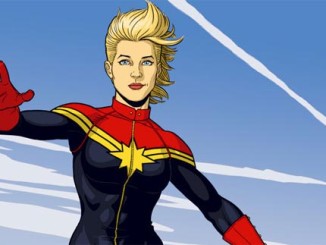
Thirty years ago, Carol Danvers, aka the cosmically powered superhero known as Captain Marvel, destroyed the Supreme Intelligence, thinking she was freeing the alien people of the Kree Empire from its dominating rule. But while the Supreme Intelligence was a despotic AI, it also controlled much of the factors that made the Kree homeworld a paradise and with its elimination, the world slid rapidly into civil war and environmental collapse. Three decades later a Kree warrior named Dar-Benn has united the various Kree factions and has now turned her attention to restoring her planet’s environmental resources by stealing them from other worlds. Re-enter Captain Marvel, who stumbles onto Dar-Benn’s plot while investigating some anomalous issues with the system of wormholes used by the various alien civilizations in the Marvel Cinematic Universe to get around. At the same time, SWORD agent Monica Rambeau, last seen in Disney+’s WandaVision series is also investigating the strange readings emanating from Earth’s local jumpgate. Through some comic book science, Carol and Monica’s powers become entangled with those of Jersey City hero teenager Kamala Khan, aka Ms. Marvel, whose own abilities are tied to a mysterious bangle similar to the one that Dar-Benn is using.
The first Captain Marvel, released in 2019 in between The Avengers: Infinity War and The Avengers: End Game as an introduction to the hero who would become instrumental in that second film, was something of a po-faced affair, taking itself fairly seriously. The Marvels, is a more lighthearted affair. Sure, there is the usual end-of-the-world stakes involved, but the film finds time to see the humor in the heroes’ location swapping predicament, a specific alien culture’s way of communicating, the return of the cat-like alien that shoots tentacles out of its mouth and more. If you are looking for something a little more weighty, the film does have a theme concerning the responsibility one might have after instituting a regime-change – always a timely topic, unfortunately – but it manages to not be developed much outside of the villain’s motivations.
Incoming director Nia DaCosta has inherited a trio of leads from previous Marvel projects, but who all have some great onscreen chemistry as if handpicked for this film. Iman Vellani is just as delightfully fangirly here as she was when we met her Kamala Khan character in Ms Marvel and the film gives her a nice arc to play going from star-struck teen to a superhero accepted and fighting as an equal alongside her idol. Teyonah Parris has more complex work to do, playing the adult version of a pre-teen character Brie’s Carol had a relationship with in Captain Marvel and having to connect with what was established previously and building on that to create the tension between the two that needs to be solved by the time the credits roll. Parris does good work here, but this particular storyline feels somewhat shorted and with this film having one of the shortest runtimes of any Marvel movie, a few moments more devoted to this would not have gone amiss.
Now it should be noted that fifteen years and twenty-some movies into the Marvel Cinematic Universe gives the impression that there is lots of background needed to be able to follow certain aspects of The Marvels. And in the past that was a bit more true for some MCU offerings. (We’re looking at you Doctor Strange And The Multiverse Of Madness.) But it feels as if the franchise has learned from those mistakes and is better at incorporating needed exposition into the films. Missed WandaVision on the Disney+ streaming service where Monica got her powers? No problem, Monica explains to Carol that she passed through a witch’s hex field and now she has super powers. Carol accepts it as just another day in the comic book physics world of the MCU, signalling that that is all the audience needs to know to continue forward. Ironic, considering that the film ends with a few indications of things ahead in the ongoing franchise.





